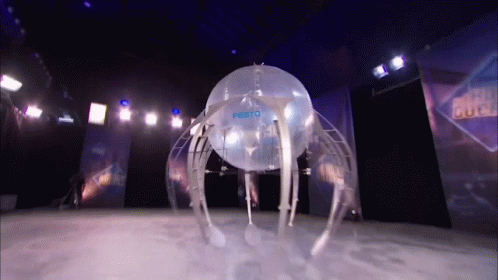
Festo is a German company with offices worldwide is a supplier of pneumatic and electrical automation technology. Some of their projects in the Bionic Learning Network mimic behaviors in nature to help us apply efficiencies in production.
“Bionic design principles serve as the basis for the development of new gripper technology for flexible adaptive grasping in the mechanical handling industry.
“In biomechatronics, Festo is investigating new approaches in the control and regulation of autonomous bionic systems, all the way up to smart system integration and the application of state-of-the-art communication technologies.”
AUQUAPENGUIN
Like its natural archetype, the AquaPenguin from Festo has a hydrodynamic body contour. Its elegant wing propulsion and its head and tail sections, which can be moved in all directions, allow the robotic penguins to manoeuvre in cramped spatial conditions, to turn on the spot when necessary and – unlike their biological counterparts – even to swim backwards.
The bionic Penguins are designed as autonomous underwater vehicles that independently orient themselves and navigate through the water basin. They are supported by a 3D sonar system which, as with dolphins, allows communication with their surroundings and with other robotic penguins – for example to avoid collisions.
An entirely new feature in robotics is the torso that can move in any direction. The bionic Fin Ray® structure, derived from the tail fin of a fish, has thus been extended into three-dimensional space for the first time. The pengins’ torso design can be used in automation in a flexible tripod configuration, thereby opening up new fields of application in mechanical handling technology.
AQUAJELLY
AquaJelly is an artificial autonomous jellyfish in water, a self-controlling system which emulates swarming behaviour. AquaJelly consists of a translucent hemisphere and eight tentacles for propulsion. At the centre of the AquaJelly is a watertight laser-sintered body. It houses a central electric motor, the two lithium-ion polymer batteries, the recharging control unit and the servo motors for the swash plate.
AIRJELLY

AirJelly’s environment is the air. Unlike AquaJelly, the remote-controlled jellyfish AirJelly does not swim through water, but instead glides instead through a sea of air thanks to its central electric drive unit and an intelligent, adaptive mechanism. It is able to do so because it consists of a helium-filled ballonett.
AirJelly’s sole source of power is two lithium-ion polymer batteries connected to the central electric drive unit. It transmits the force to a bevel gear and from there to a succession of eight spur gears, which move the eight tentacles of the jellyfish via cranks. Each tentacle is designed as a structure with Fin Ray Effect® . Propulsion of a ballonett by means of peristaltic motion is hitherto unknown in the history of aviation. AirJelly is the first indoor flight object with peristaltic drive. This new drive concept, with propulsion based on the principle of recoil, moves the jellyfish gently through the air.
Dig into this company at their website: Festo.com >>